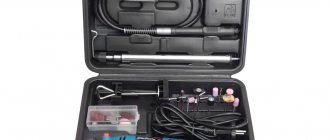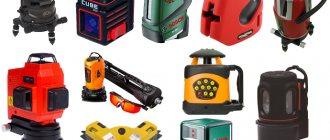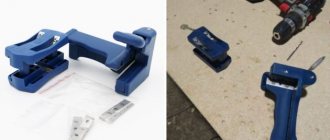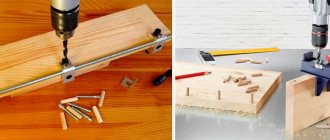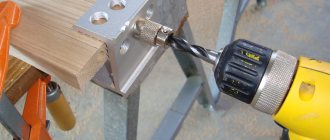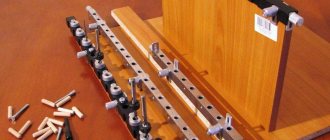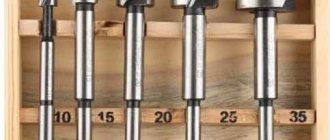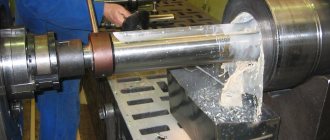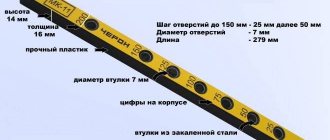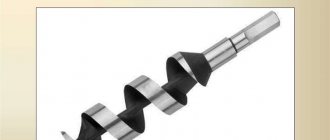Overview of species
Modern industry produces a wide range of jigs: self-centering for precise drilling, for 90-degree corner connections, for creating end holes. For vertical or perpendicular drilling, strips with different diameters of internal bushings are suitable. A carpenter's jig for slanted or rectangular holes is well suited for working with wood or wood-based materials.
By purpose
According to the area of application, all conductors are usually divided into categories. For example, furniture or overhead options are suitable for chipboard, laminated chipboard, boards, and other flat sheet materials. Separately, models are made for dowels - for drilling holes in the end for protruding fastening elements, for a confirmatory screw. For round pipes and cylindrical workpieces, rotary or universal options are used - they eliminate the displacement of the drill during work. For sheet metal, flat workpieces, when attaching an aluminum profile, you can use a universal version or a special one for self-tapping screws.
When forming holes in tiles and porcelain stoneware, it is customary to use crowns - special drills. When working with them, it is better to immediately purchase a kit with a suitable conductor so as not to experience difficulties with selection.
Diamond bits and drills are in demand when working with other hard materials: concrete, stone. They are usually equipped with a water supply device to prevent overheating.
Installation of frames and socket boxes requires the use of additional devices. Most often these are simple templates made of plexiglass or plywood or boards. They help to keep its contents inside the hole when modeling and pouring mortar, installing sheets, without losing the specified geometry. By analogy, such elements are called jigs, although they do not participate in the drilling process. They are usually used if you need to install 3–5 socket boxes in a row.
By design
The type of conductor design largely determines its functionality. Among the types used by craftsmen in different fields of activity, there are four most popular options.
Invoices. During operation, the jig comes into contact with its flat edge to the surface of the material being drilled and is pressed with clamps or hands. This variety is focused on working on a plane; it is often also called furniture. The best choice for an overhead jig is when working with chipboard, MDF and other wood boards.
Popular models
PRACTICE 247-026
This is one of the simplest and most inexpensive jigs, designed for drilling holes with a diameter of 4-10 mm. The tool is made of plastic, has a round shape with patterns of holes of different sizes around the circumference. There is a special rubber rim to collect dust and chips. Buyers of this conductor note its budget price and ease of use as advantages. The main disadvantage is rapid wear.
Bison 29853
The jig is designed for use with diamond tubular drills. Hole diameters are 4, 6, 8, 10 and 12 mm. There is a rubber suction cup as a retainer. The tool is also equipped with the ability to force water supply to avoid overheating.
Among the positive features, buyers note:
- Affordable price.
- Sufficiently reliable fixation on ceramic surfaces.
- Drilling accuracy.
- Overheating insurance.
The main disadvantage of the device, like all conductors in the budget segment, is rapid wear. However, this is compensated by an affordable price, which makes it possible to consider such tools more as a replaceable consumable for repair work.
PRACTICE 771-411
This instrument belongs to the Russian “Expert” series. It is used as a guide for diamond bits with a diameter of 14 to 70 mm. The conductor is made of steel; a rubber suction cup acts as a retainer. According to the manufacturer, thanks to the design of the guide, the side layer of diamond bits does not wear out. This is confirmed by the buyers of this conductor.
Kwb Dubelprofi, 7580-00
The tool produced by the Czech company Kwb is more universal. It is equipped with templates for drilling holes from 3 to 12 mm. The bar acts as a parallel stop. There is a depth gauge. Despite the presence of a stop bar, owners report some difficulties in fixing the device. However, the tool is popular due to its low price and ergonomic use. On the plus side, good drilling accuracy is also noted.
Bosch 2607000549
The jig is designed for drilling holes for dowels. Templates include the most common diameters - from 3 to 12 mm. Designed for work on both wood and steel, therefore it is a universal jig. For fixation, the tool is equipped with a stop with a clamping screw, as well as a handle for ease of use. In general, reviews about this device are positive. The only drawback is the plastic material, which is prone to wear out quickly.
Kreg K3DGB
This is a more professional jig that allows you to drill holes in large diameter parts. The attachment is replaceable and is sometimes used as part of a Kreg drill kit. The design is designed for drilling both perpendicularly and at an acute angle. Owners note the reliability of the device and the versatility of its use.
Kreg Kma3200
An overhead jig designed for drilling vertical holes when assembling furniture, repairing, etc.
Included are:
- The conductor himself.
- Clamp clamp.
- Restrictor ring.
- Positioning pin.
- Drill 1-1/4.
- Connecting strip.
Thus, in essence, this is a whole kit for accurate and high-quality drilling. The conductor also comes with a user manual for assembling and using the device. The tool has earned positive reviews from customers, mainly highlighting its accuracy and reliability.
Classification of tools
Based on functionality and design functionality, drilling jigs are divided into types:
- invoices. The name comes from their functional way of working, that is, they are applied to the workpiece or the surface being processed, attached to it with special clamps or held by hand. This device is suitable for drilling flat surfaces, such as boards, MDF boards and chipboards. It is called a furniture jig for drilling holes. Thanks to the use of a jig, the holes themselves are very neat and precise;
- rotary. Such templates are ideal for drilling round or cylindrical surfaces. Thanks to this design, the axis occupies a horizontal, vertical and inclined position to the surface. This is possible thanks to bushings that can guide the drilling line;
- universal. Products of this design are widely popular in small industrial production, where quick adjustment to the existing surface plays an important role. Due to their uniqueness, they are also in demand in the household, when you have to work with different materials, planes and surfaces; tiltable. In terms of functionality they are somewhat reminiscent of universal ones. They are necessary when you need to make a hole in different planes and at different slopes. This is very convenient for carrying out some repair work when you need to drill a hole in the wall without a lot of time and at a specific angle;
- sliding. According to its name, such a conductor does not have to be attached to the surface where it is supposed to be applied. It should be noted that such a conductor is inconvenient to use, since it requires constant hand holding;
- fixed. Unlike sliding jigs, they are attached to the place where they are intended to be used. They are much easier to attach, but due to their design they limit the scope of human work. This can be clearly seen when working on walls or vertical planes with only one spindle.
Jig for angled holes
A jig for drilling holes at an angle is used for assembling furniture. It is often used for drilling not too thick MDF boards or chipboards, plywood. Also used in production. They can be manufactured either in a specialized design, for specific operations, or in a more universal form. They reduce the time required to make inclined holes. Moreover, it will not be possible to make them exactly the same by eye.
At home you don’t often have to drill at an angle, but the need arises. This kind of conductor can be made independently, or you can buy it. The reason is that if you do not engage in mass production, then preparing templates for non-standard holes will most likely not justify the costs. It will be easier and cheaper to try to drill the hole as needed, but with small deviations, than to make templates. It may never be useful again. It's up to the owner to decide.
Scope of use
Furniture jigs are devices that no furniture maker can do without while working. Such devices allow you to avoid the main problem in furniture production, namely the drill entering at the wrong angle. If you make such a mistake, it is very difficult or even impossible to correct it later. Such a device not only makes it possible to correctly direct the drill during operation, but also allows the tool to constantly maintain the desired trajectory (flat, perpendicular or at an angle).
Such devices are used both in the design and production of furniture, and during assembly, when there is a need to make holes for fastening elements together. Often, for such actions, conductors are used for firmmats or dowels, without which it is impossible to make straight holes
Also, you cannot do without this device if you need to make holes at an angle or in the end of a thin slab (it is especially important to use the device when working with chipboards)
When drilling holes using this design, the process itself is quick and simple. The fastener allows you to do work at any distance from the edge of the slab, as well as regardless of its width.
In the furniture industry, dowels are often used as fasteners. But at the same time, this option has already existed for a long time, and their use requires the presence of a drilling jig when working. The only condition and at the same time a problem is the fact that the parts being connected to each other must have a right angle during operation. Therefore, such elements must be located exactly perpendicular to each other. When making holes for dowels and adding parts, it will be very difficult to do without a jig.
Furniture production is not the only area of application for such devices. They can often be used to make holes in pipes and other round-shaped parts. Special devices allow you to make high-quality holes even in the smallest tubes.
Purchased or homemade: which is better?
When assembling furniture, the use of such a device is mandatory. Some people prefer to buy a ready-made version in a store, while many make them themselves.
As for sale, they can be found in almost every hardware store. However, it may turn out that the purchased equipment may not suit your needs.
The cost of products is influenced by the following factors:
- method of use;
- size range;
- manufacturer.
Simple equipment is inexpensive, but products with additional functions will cost more.
Having a little idea about the conductor and some tools, you can make it yourself.
Purpose
This device is required to guide the drill with high precision to a given location, while ensuring the straightness and accuracy of its passage along the entire depth of drilling the hole. When working with a hand drill, it is quite difficult to maintain a given direction. If it is necessary to make a series of holes at a certain distance from each other, you have to make markings for each of them. The template for furniture has through holes for the insertion of a drill, the locations of which correspond to the drawing of the product.
In the absence of a conductor, you have to resort to a more labor-intensive method - marking marking lines. A core is a depression on the surface when struck with a hammer on a special cone called a center punch. When installing the conductor above a given point, you can start working without capping. The drill will hit the desired point accurately and does not deviate from the specified direction.
The conductor is used at the stage of assembly, fastening fittings and other technological operations. If it is necessary to make several rows of holes according to a template, the jig saves significant time. A jig is practically irreplaceable when the holes are planned in a rounded shape. When pressed, the end of the drill jumps off from the place indicated in the drawing. The jig is fixed to the part and performs the job accurately.
Metal structures are used for almost any furniture except wood. They are often pipes through which a series of holes must be drilled
In this case, when manufacturing the conductor, special attention should be paid to securely fastening it to the metal pipe. As a rule, the drilling angle should be 90˚
A rarer and more difficult option is “oblique” drilling. In this case, the length of the fixing elements should be adjusted. It is impossible to drill tangentially just by holding the drill in your hands. Working with a furniture jig makes this process a breeze. The height should be set. In this case, the workpiece is pressed tightly against the stop. The holes are precise and at the required angle.
A significant advantage of using a template guide for furniture products is that the holes are coaxial. When using a conductor, there is no need to make calculations and mark locations for holes. This reduces labor intensity and reduces operating time.
Even a simple device in the form of a strip with a stop greatly facilitates and speeds up the process of making holes of the same type
Main types
Based on the type of design and functionality, devices used for adding (drilling) holes in elements of furniture structures may fall into one of the following categories.
Invoices
These are jigs that are applied to the surface of the workpiece and either fixed on it or held in a given position by hand. Using such a device for making furniture, holes are made in flat parts (for example, in slabs made of chipboard or MDF).
Rotary
The working bar of such conductors can rotate in both horizontal and vertical planes. Using this device, you can make holes in parts of complex geometric shapes. Such a jig is used for drilling holes whose axis is located at an angle.
Universal
These are reconfigurable jigs for making furniture. It is advisable to use devices of this type in production shops that produce furniture in small batches. The versatility of such jigs for furniture production lies in the fact that they can be quickly reconfigured to different combinations of the location of the holes being made.
Tiltable
Conductors of this type are used in cases where it is necessary to drill holes in several planes.
In addition, more highly specialized jig devices are actively used in furniture production (in particular, a dowel jig for assembling furniture and a device that makes it possible to accurately and efficiently make holes for confirmations).
Using a jig when drilling the end of furniture boards will protect you from accidental drift of the drill to the side and, as a result, damage to the workpiece
According to the method of fixation on the surface of the workpiece, jigs are divided into sliding and fixed type devices. Devices that are fixed to the part before processing, although more convenient to use, somewhat limit the freedom of action of the master. This is especially critical in cases where drilling is performed on a machine equipped with a single spindle mechanism.
Using a jig, it is possible to avoid a rather serious problem: the drill entering the surface of the workpiece at the wrong angle. Coping with this problem, if it has already arisen, is quite difficult, and in many cases simply impossible. When using a jig, the drill not only enters the material being processed at the required angle, but also does not deviate from the specified direction throughout the entire drilling process. You cannot do without a jig in cases where it is necessary to drill a hole at a certain angle in thin furniture boards made of chipboard or MDF.
Some drilling operations (for example, making oblique holes) simply cannot be done without special tools
Setting up the production of furniture with your own hands, if you use conductors in such production, is possible even for a person who is not highly qualified and does not have sufficient experience in this field. When using such devices, there is no need to perform complex preliminary calculations and mark out locations for future holes.
Self-production
To work, you need to prepare the following materials and tools:
- metal sheet or wooden board;
- welding machine;
- angle grinder;
- drill;
- screwdrivers;
- wire cutters;
- sandpaper;
- pliers;
- reinforcement measuring 10*10 mm.
Next, follow the following instructions:
- Make a blank. It must be cleaned with sandpaper. Mark future holes. There is a standard for this that says the distance between centers should be 32mm.
- We carry out drilling.
- The next step is to make a support from a metal plate. Its thickness should be 1 mm. It needs to be bent and the place for the thread marked.
- Connect the two parts together.
Advantages and disadvantages
According to its functional purpose, the jig acts as a template according to which it is necessary to drill a hole in the required material with maximum accuracy to the original. This template greatly facilitates the work of the master when he needs to drill a strictly vertical, horizontal or inclined hole.
The master no longer needs to make sketches and measurements, having such a tool with him. The drill is positioned strictly at the required angle, which is necessary during the work process and cannot deviate. This improves the accuracy of the work, which can be seen in deep holes.
To work with furniture, the conductor must meet the following requirements:
- it should help and speed up the furniture assembly process and not require the use of complex equipment;
- allow you to make several holes at once without the need for manual markings;
- improve work with a drill;
The materials from which conductors are made have different strength characteristics. These are mainly plastic and glass made from organic raw materials. But the strongest ones are made from metals, namely steel. Therefore, when choosing, you should pay attention to the following characteristics:
- minimal deformation under heavy loads;
- clear drill direction axis;
- no heating during operation.
In furniture production, lighter conductors are used that are easy to handle. Factory or homemade options can be used.
It should be noted that a real master has a trained eye, so often he does not need all these devices to make the hole correctly.
A clear advantage of such tools is ease of use. With their help, even an inexperienced person can perform all the work at the level of a skilled worker. Here you don’t even need to do any complex calculations or have enormous experience. Its main purpose is to speed up the work process many times over.
Dowel hole jig
The jig for drilling holes for dowels is one of the simplest templates in its design. However, you should know that such templates should simplify the work of the master, and not complicate it when he is forced to use complex instruments.
Dowel hole jig
Used for assembling furniture. Should allow simultaneous drilling of holes without changing the device. For manufacturing, different materials are used that have different strength characteristics. The most durable unit can be considered a steel unit.
Application
Drilling jigs are used in many fields of activity. Most often in construction. But besides this, there are several other important industries.
Furniture
During assembly, many craftsmen are faced with a problem such as a lack of holes. In this case, you have to make new ones yourself. To do this easily, it is recommended to use a jig. With its help, all work will be done quickly, efficiently and accurately. Craftsmen who do not have a special machine should also resort to the help of such a device.
Modern assembly is distinguished by a wide selection of furniture fittings and various fasteners. All this requires precise installation without displacement. This is where the conductor will help.
Pipes
Making holes of the correct shape on cylindrical surfaces is quite difficult. Using a drill in this case is useless. It will constantly slide off, which means they will all turn out to be of irregular shape. For this, it is recommended to use a conductor.
Additionally, you can use devices that help make perpendicular holes. It will also help to process rounded elements and edges.
What it is?
The jig is a plate on which holes and sleeves are located. Even a beginner can use such equipment. It only takes a few steps:
- the equipment is fixed in the right place;
- a drill is inserted into the sleeve;
- a hole is carefully made.
To fasten two parts you only need one jig.
How to choose
Do you use a drilling jig in your work?
I always want to try
When choosing a marker for drilling, it is recommended to pay attention to the following points:
As a rule, cheap conductors are made of plastic. However, this is an unreliable material that quickly grinds down and wears out. Therefore, it is recommended to buy a device with steel sleeves.
Purpose
How highly specialized the tool is. You should focus on what type of work the conductor will be used for.
This point is closely related to purpose. If furniture assembly work is carried out, you may need both an overhead and a sliding tool, depending on the specific stage of assembly.
Type of lock
Clamp or suction cup. For construction work on a vertical plane, a rubber suction cup is more suitable, which allows you to move the marker to any desired location.
Expert opinion Pavel Maksimovich Torsunov
You should also focus on the reputation and name of the manufacturer. For example, the Russian one has gained popularity, which produces both universal and highly specialized conductors. Markers from well-known global tool suppliers – Bosch, Kreg, and others – are also popular.
